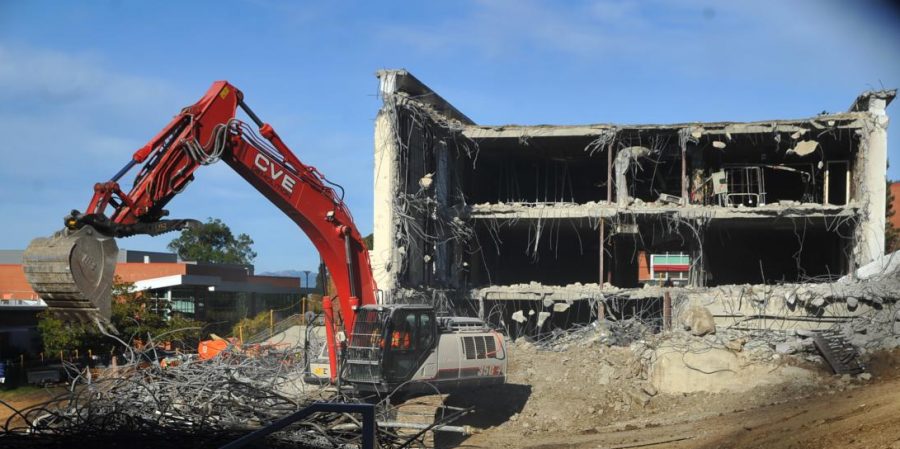Demolition process rolls on
Central Valley Environmental continues demolishing the Liberal Arts Building on Oct. 24. The demolition process should finish and the construction process begins August 2019.
Nov 7, 2018
The discovery of hazardous products on the foundation of the old Health Sciences Building in recent weeks stalled its demolition until removal was complete creating a delay on demolishing the building and its companion, the Liberal Arts Building.
But once the dangerous waste was out of the way, the demolition has continued as planned. Currently, the Health Sciences Building is completely demolished, and the Liberal Arts Building is half gone.
While construction workers were drilling to remove the foundation of the building, they stumbled upon thermal paper and had to stop the drilling to wait for a company that specializes in hazardous waste removal to complete the job to conform to safety standards. Project foreman Luis Almena said, “The schedule is a little behind because of the problems with the abatement, but we still have to remove everything under the ground.”
According to the Mesothelioma Justice Network, thermal paper was often used to insulate pipes, machine gaskets and in electrical insulation. It was also commonly used as a backing for fiberboard. Before the 1980s, a lot of thermal paper was made using asbestos.
CSI Solutions Project Industrial Hygienist Michael D. Harrington said, “At this time, there is no more hazardous waste on site. All kinds of waste were removed, and there is a list of potential hazards that have been removed, such as floor tile, piping and joint compound.”
The construction of a new science complex will be completed in three phases — 1) the demolition of the old building; 2) the labeling of the terrain for the new foundation; and 3) the construction of the building.
The new building, yet to be officially named, is expected to be ready for occupancy in 2023.
Plans to demolish the Health Sciences and Liberal Arts buildings were tailored to be least intrusive to student’s daily activities. This method involves various demolition machinery, mainly a hammer and a crusher. The hammer loosens up big pieces of concrete and the crusher pulverizes the concrete preventing debris from flying around and hurting bystanders.
While these machines are doing their job, construction workers can be seen spraying water on the affected areas to reduce the dust.
Buildings and Grounds Manager Bruce King said, “Demolitions in California are more challenging because they have to be done in an environmentally conscious way. In our case, the materials are separated. The metal rebar goes to a recycling location and the concrete goes to quarries where it has to be ground and reused.”
Even though the demolition workers have encountered some problems such as the breakdown of three hammerheads, the demolition must be completed no later than Jan. 15. But according to scheduling and their current pace, they hope to be done by the end of November.
After the demolition is complete, the science building project will be submitted into a bidding process with general contractors in order to choose the company that will grade the terrain to get it ready for the foundation of the building to be constructed.
The deadline for results from the bidding must be submitted by Dec. 12.
This part of the process is expected to tricky for the construction workers because they have to work in the rainy season.
King said, “Progress will depend on how much rain we get. If we don’t get too much rain, then we get to do more work. Otherwise, we’ll have to stop for a week or two until everything dries.”
Once the utilities are installed, the project will be submitted for bid again in order to contract with the company that will do the actual construction of the new science building.
The construction phase of the project is expected to begin in August 2019.




Carl Wapniss • Nov 8, 2018 at 1:48 pm
I am confused by what they are calling ‘thermal paper’ here. The thermal paper we are most familiar with is the type of papers we see as POS receipts and chicken labels. At no time since that product was created has it ever contained asbestos. NEVER. Earlier versions of thermal imaging papers from the 1950’s and 1960’s used metallic salts but they were rather expensive and rare. They were never used as pipe insulation. NEVER. Maybe this is heat resistance paper?